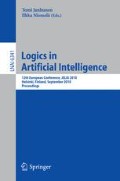Abstract
We present a new semantics for Description Logic programs [1] (dl-programs) that combine reasoning about ontologies in description logics with non-monotonic rules interpreted under answer set semantics. Our semantics is equivalent to that of [1], but is more logical in style, being based on the logic QHT of quantified here-and-there that provides a foundation for ordinary logic programs under answer set semantics and removes the need for program reducts. Here we extend the concept of QHT-model to encompass dl-programs. As an application we characterise some logical relations between dl-programs, by mating the idea of QHT-equivalence with the concept of query inseparability taken from description logics.
Partially supported by the MCICINN projects TIN2006-15455, TIN2009-14562-CO5, and CSD2007-00022, as well as by the WWTF project ICT08-020.
Access this chapter
Tax calculation will be finalised at checkout
Purchases are for personal use only
Preview
Unable to display preview. Download preview PDF.
References
Eiter, T., Lukasiewicz, T., Schindlauer, R., Tompits, H.: Combining answer set programming with description logics for the semantic web. In: KR, pp. 141–151. AAAI Press, Menlo Park (2004)
Rosati, R.: Dl+log: Tight integration of description logics and disjunctive datalog. In: KR, pp. 68–78. AAAI Press, Menlo Park (2006)
Rosati, R.: On the decidability and complexity of integrating ontologies and rules. J. Web Sem. 3(1), 61–73 (2005)
Rosati, R.: Semantic and computational advantages of the safe integration of ontologies and rules. In: Fages, F., Soliman, S. (eds.) PPSWR 2005. LNCS, vol. 3703, pp. 50–64. Springer, Heidelberg (2005)
Heymans, S., de Bruijn, J., Predoiu, L., Feier, C., Nieuwenborgh, D.V.: Guarded hybrid knowledge bases. TPLP 8(3), 411–429 (2008)
Eiter, T., Ianni, G., Schindlauer, R., Tompits, H.: A uniform integration of higher-order reasoning and external evaluations in answer-set programming. In: IJCAI, pp. 90–96 (2005)
Pearce, D., Valverde, A.: Quantified equilibrium logic and foundations for answer set programs. In: Garcia de la Banda, M., Pontelli, E. (eds.) ICLP 2008. LNCS, vol. 5366, pp. 546–560. Springer, Heidelberg (2008)
Pearce, D.: Equilibrium logic. AMAI 47(1-2), 3–41 (2006)
Lutz, C., Wolter, F.: Conservative extensions in the lightweight description logic \(\mathcal{EL}\). In: Pfenning, F. (ed.) CADE 2007. LNCS (LNAI), vol. 4603, pp. 84–99. Springer, Heidelberg (2007)
Lutz, C., Walther, D., Wolter, F.: Conservative extensions in expressive description logics. In: IJCAI, pp. 453–458 (2007)
Kontchakov, R., Wolter, F., Zakharyaschev, M.: Can you tell the difference between dl-lite ontologies? In: KR, pp. 285–295. AAAI Press, Menlo Park (2008)
Lifschitz, V., Pearce, D., Valverde, A.: Strongly equivalent logic programs. ACM TOCL 2(4), 526–541 (2001)
Fink, M.: A general framework for equivalences in answer-set programming by countermodels in the logic of here-and-there. In: TPLP (2010) (forthcoming)
Fink, M.: Equivalences in answer-set programming by countermodels in the logic of here-and-there. In: Garcia de la Banda, M., Pontelli, E. (eds.) ICLP 2008. LNCS, vol. 5366, pp. 99–113. Springer, Heidelberg (2008)
Lifschitz, V., Pearce, D., Valverde, A.: A characterization of strong equivalence for logic programs with variables. In: Baral, C., Brewka, G., Schlipf, J. (eds.) LPNMR 2007. LNCS (LNAI), vol. 4483, pp. 188–200. Springer, Heidelberg (2007)
Faber, W., Leone, N., Pfeifer, G.: Recursive aggregates in disjunctive logic programs: Semantics and complexity. In: Alferes, J.J., Leite, J. (eds.) JELIA 2004. LNCS (LNAI), vol. 3229, pp. 200–212. Springer, Heidelberg (2004)
Pearce, D., Valverde, A.: Quantified equilibrium logic an the first order logic of here-and-there. Technical Report MA-06-02, Univ. Rey Juan Carlos (2006)
van Dalen, D.: Logic and Structure, 4th edn. Springer, Heidelberg (2004)
Baral, C.: Knowledge Representation, Reasoning, and Declarative Problem Solving. Cambridge University Press, Cambridge (2003)
Heymans, S., Nieuwenborgh, D.V., Vermeir, D.: Open answer set programming with guarded programs. ACM TOCL 9(4) (2008)
Ferraris, P., Lee, J., Lifschitz, V.: A new perspective on stable models. In: IJCAI, pp. 372–379 (2007)
Pearce, D., Valverde, A.: A first order nonmonotonic extension of constructive logic. Studia Logica 80(2-3), 321–346 (2005)
Eiter, T., Ianni, G., Lukasiewicz, T., Schindlauer, R., Tompits, H.: Combining answer set programming with description logics for the Semantic Web. AIJ 172(12-13), 1495–1539 (2008)
Baader, F., Calvanese, D., McGuinness, D., Nardi, D., Patel-Schneider, P. (eds.): The Description Logic Handbook: Theory, Implementation and Applications. Cambridge University Press, Cambridge (2003)
Lutz, C., Wolter, F.: Deciding inseparability and conservative extensions in the description logic el. J. Symb. Comput. 45(2), 194–228 (2010)
Kontchakov, R., Wolter, F., Zakharyaschev, M.: A logic-based framework for ontology comparison and module extraction in dl-lite (2010) (submitted)
Fink, M., Pearce, D.: Some equivalence concepts for hybrid theories. In: CAEPIA, Spanish Association for Artifical Intelligence, pp. 327–336 (2009)
Author information
Authors and Affiliations
Editor information
Editors and Affiliations
Rights and permissions
Copyright information
© 2010 Springer-Verlag Berlin Heidelberg
About this paper
Cite this paper
Fink, M., Pearce, D. (2010). A Logical Semantics for Description Logic Programs . In: Janhunen, T., Niemelä, I. (eds) Logics in Artificial Intelligence. JELIA 2010. Lecture Notes in Computer Science(), vol 6341. Springer, Berlin, Heidelberg. https://doi.org/10.1007/978-3-642-15675-5_15
Download citation
DOI: https://doi.org/10.1007/978-3-642-15675-5_15
Publisher Name: Springer, Berlin, Heidelberg
Print ISBN: 978-3-642-15674-8
Online ISBN: 978-3-642-15675-5
eBook Packages: Computer ScienceComputer Science (R0)

